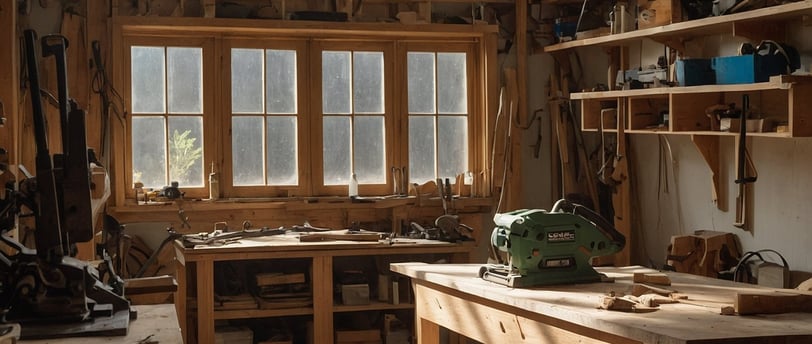Woodworking is an incredibly rewarding hobby that allows you to create beautiful, functional pieces from scratch. For beginners, however, it can seem a bit daunting. From selecting the right materials to understanding the tools and techniques, there’s a lot to learn. But don’t worry! With a little patience and practice, you can get the hang of it and enjoy the process of creating something unique.
In this article, we’ll share the Top 10 Woodworking Tips for Newbies that will help you avoid common mistakes and improve your skills quickly. These tips cover everything from selecting tools to mastering the basics, ensuring that you start your woodworking journey on the right foot.
1. Start with Simple Projects
When you’re just starting out, it’s easy to get excited and want to dive into complex projects. However, it’s important to start with something manageable to build your skills. Simple projects like a small bookshelf, birdhouse, or wooden tray will teach you the basics of cutting, joining, and finishing without overwhelming you.
Pro Tip: Choose projects that involve basic tools like a saw, drill, and sander. As you gain confidence, you can move on to more advanced pieces.
2. Invest in Essential Tools
As a beginner, you don’t need to buy every woodworking tool under the sun. Instead, start by investing in a few essential tools that will cover the basics:
Measuring tape: Precision is key in woodworking.
Circular saw or handsaw: For cutting wood to size.
Cordless drill: For drilling holes and driving screws.
Clamps: To hold pieces of wood securely while working.
Sanding block or electric sander: For smoothing surfaces.
Once you’ve mastered these tools, you can gradually expand your collection with more specialized equipment.
3. Learn to Measure and Mark Accurately
One of the most important skills in woodworking is accurate measuring and marking. A tiny error in measurement can lead to poor-fitting joints, uneven surfaces, or wasted materials.
Use a carpenter’s square to ensure 90-degree cuts.
Double-check measurements before cutting to avoid mistakes.
Always use a sharp pencil or marking knife for clear, precise lines.
Pro Tip: Follow the old woodworking adage: “Measure twice, cut once.”
4. Understand Wood Grain and Its Importance
The direction of the wood grain significantly affects how wood behaves when cut, sanded, or joined. Always pay attention to the grain for a smooth and strong finish:
Cut with the grain: Cutting against the grain can result in tear-outs and rough edges.
Sand with the grain: Sanding against the grain can leave scratches that show up once you apply the finish.
Join with the grain in mind: Wood expands and contracts along the grain, so plan your joints to accommodate natural wood movement.
Understanding the grain will lead to better quality projects and prevent warping or splitting.
5. Practice Safety First
Woodworking involves sharp tools, heavy materials, and potentially hazardous power equipment, so safety should always be a top priority.
Always wear safety glasses to protect your eyes from flying debris.
Use ear protection when working with loud power tools.
Wear a dust mask to avoid inhaling sawdust, which can be harmful over time.
Keep your work area clean and free from clutter to prevent accidents.
Pro Tip: Never work with power tools when you're tired or distracted—safety comes first!
6. Use Quality Materials
While it might be tempting to save money by buying cheaper wood, investing in quality materials will improve the outcome of your project. Cheap, warped, or knotty wood can lead to frustration and poor results. For beginners, consider the following options:
Pine: Affordable and easy to work with, but softer and more prone to dents.
Oak: Hard, durable, and great for furniture, but more difficult to cut and shape.
Birch plywood: Good for making cabinets and storage units due to its stability and smooth surface.
Pro Tip: Always inspect wood for defects like cracks or warping before purchasing.
7. Learn Basic Joinery Techniques
Joining pieces of wood together is a fundamental part of woodworking. There are many different joinery techniques, but as a beginner, you can start with a few simple ones:
Butt joints: Two pieces of wood joined at their ends, typically with screws or nails.
Dowels: Wooden pegs inserted into matching holes to strengthen joints.
Pocket holes: Angled holes drilled into one piece of wood to attach it to another.
Mastering these basic joints will help you build sturdy and attractive projects.
8. Sand Properly for a Smooth Finish
A smooth, professional-looking finish begins with proper sanding. Sanding not only smooths out rough surfaces but also prepares the wood for staining or painting.
Start with a coarse grit sandpaper (80-120 grit) to remove rough spots.
Finish with a fine grit sandpaper (220 grit or higher) for a smooth surface.
Always sand with the grain to avoid scratches.
Pro Tip: Wipe the wood with a damp cloth after sanding to remove dust before applying any finish.
9. Don’t Rush the Finish
Once you’ve completed your project, it’s tempting to rush through the finishing process. However, applying a proper finish is what will make your project stand out. Here are a few finishing tips:
Use stain to highlight the natural beauty of the wood grain.
Apply polyurethane or varnish for a protective, glossy finish.
Consider using furniture wax for a more subtle, matte finish.
Apply thin coats of finish, allowing each to dry completely before applying the next. Sand lightly between coats for the smoothest results.
10. Learn from Mistakes
Woodworking, like any craft, requires practice. Don’t be discouraged if your first few projects don’t turn out perfect—mistakes are part of the learning process.
Keep a positive mindset and view each project as an opportunity to improve.
Learn from your errors—whether it’s an incorrect measurement or a crooked cut, understanding what went wrong helps you avoid similar mistakes in the future.
Pro Tip: Save offcuts and scrap wood to practice techniques or test finishes before applying them to your final project.
Conclusion
Woodworking is a skill that improves with practice, and these Top 10 Woodworking Tips for Newbies will help you avoid common pitfalls and speed up your learning curve. From mastering measurement and joinery techniques to sanding for a smooth finish, these tips are designed to build your confidence and skill set as you embark on your woodworking journey. Remember, take your time, enjoy the process, and most importantly—have fun!




